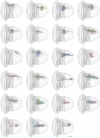RealNeuralNetworks.jl: An Integrated Julia Package for Skeletonization, Morphological Analysis, and Synaptic Connectivity Analysis of Terabyte-Scale 3D Neural Segmentations
- PMID: 35311003
- PMCID: PMC8924549
- DOI: 10.3389/fninf.2022.828169
RealNeuralNetworks.jl: An Integrated Julia Package for Skeletonization, Morphological Analysis, and Synaptic Connectivity Analysis of Terabyte-Scale 3D Neural Segmentations
Abstract
Benefiting from the rapid development of electron microscopy imaging and deep learning technologies, an increasing number of brain image datasets with segmentation and synapse detection are published. Most of the automated segmentation methods label voxels rather than producing neuron skeletons directly. A further skeletonization step is necessary for quantitative morphological analysis. Currently, several tools are published for skeletonization as well as morphological and synaptic connectivity analysis using different computer languages and environments. Recently the Julia programming language, notable for elegant syntax and high performance, has gained rapid adoption in the scientific computing community. Here, we present a Julia package, called RealNeuralNetworks.jl, for efficient sparse skeletonization, morphological analysis, and synaptic connectivity analysis. Based on a large-scale Zebrafish segmentation dataset, we illustrate the software features by performing distributed skeletonization in Google Cloud, clustering the neurons using the NBLAST algorithm, combining morphological similarity and synaptic connectivity to study their relationship. We demonstrate that RealNeuralNetworks.jl is suitable for use in terabyte-scale electron microscopy image segmentation datasets.
Keywords: Julia language; clustering; connectomics; morphological analysis; neuron connectivity; neuron morphology; skeletonization.
Copyright © 2022 Wu, Turner, Bae, Vishwanathan and Seung.
Conflict of interest statement
HS has financial interests in Zetta AI LLC. This study received assistance from Google, Amazon, and Intel. These companies were not involved in the study design, collection, analysis, interpretation of data, the writing of this article, or the decision to submit it for publication. The remaining authors declare that the research was conducted in the absence of any commercial or financial relationships that could be construed as a potential conflict of interest.
Figures






Similar articles
-
Igneous: Distributed dense 3D segmentation meshing, neuron skeletonization, and hierarchical downsampling.Front Neural Circuits. 2022 Nov 25;16:977700. doi: 10.3389/fncir.2022.977700. eCollection 2022. Front Neural Circuits. 2022. PMID: 36506593 Free PMC article.
-
MRIReco.jl: An MRI reconstruction framework written in Julia.Magn Reson Med. 2021 Sep;86(3):1633-1646. doi: 10.1002/mrm.28792. Epub 2021 Apr 4. Magn Reson Med. 2021. PMID: 33817833
-
SBMLToolkit.jl: a Julia package for importing SBML into the SciML ecosystem.J Integr Bioinform. 2024 May 28;21(1):20240003. doi: 10.1515/jib-2024-0003. eCollection 2024 Mar 1. J Integr Bioinform. 2024. PMID: 38801698 Free PMC article.
-
A next-generation dynamic programming language Julia: Its features and applications in biological science.J Adv Res. 2024 Oct;64:143-154. doi: 10.1016/j.jare.2023.11.015. Epub 2023 Nov 21. J Adv Res. 2024. PMID: 37992995 Free PMC article. Review.
-
Physiological signal analysis and open science using the Julia language and associated software.Front Netw Physiol. 2024 Nov 6;4:1478280. doi: 10.3389/fnetp.2024.1478280. eCollection 2024. Front Netw Physiol. 2024. PMID: 39569020 Free PMC article. Review.
Cited by
-
Igneous: Distributed dense 3D segmentation meshing, neuron skeletonization, and hierarchical downsampling.Front Neural Circuits. 2022 Nov 25;16:977700. doi: 10.3389/fncir.2022.977700. eCollection 2022. Front Neural Circuits. 2022. PMID: 36506593 Free PMC article.
References
-
- AWSSDK.jl (2021). JuliaCloud. Available online at: https://github.com/JuliaCloud/AWSSDK.jl (accessed February 1, 2022).
LinkOut - more resources
Full Text Sources

